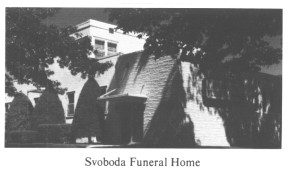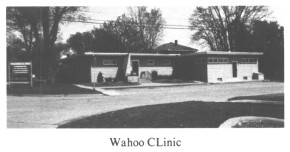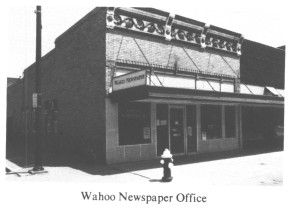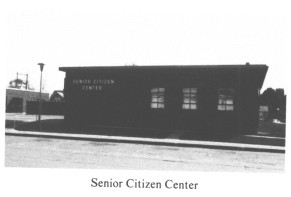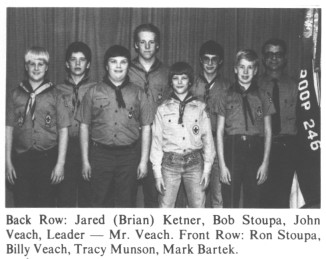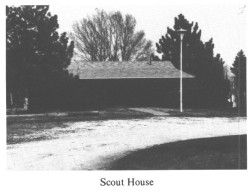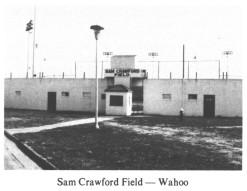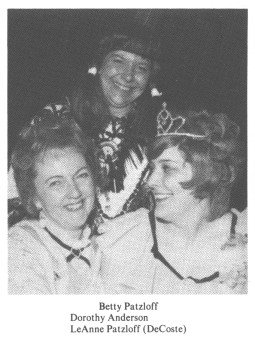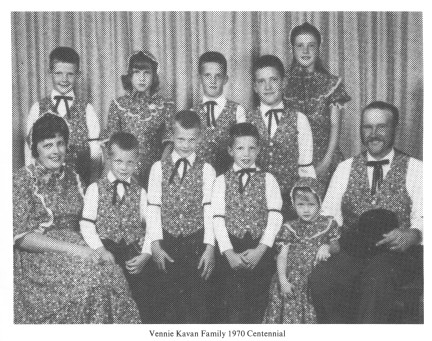 |
STOCKING PRECINCT |
|
en organizations. They were American Red Cross, Arthritis Foundation, Blood Bank Program, Boy Scouts, Crippled Children, CROP, Girl Scouts, Salvation Army, Saunders County Mentally Retarded Children, Saunders County Mental Health Assn., and the Senior Citizens Program. Many of the original organizations are still being served today. In the year, 1983, the Chest will serve 15 organizations: Arthritis Foundation, Blood Bank Program, Boy Scouts, Cystic Fibrosis, Girl Scouts, Red Cross, Salvation Army, Saunders Co. Mental Health, Senior Citizens Program, Saunders Co. Youth Service System, Cancer Fund, Heart Fund, Wahoo Youth Athletic Assn., Juvenile Diabetes Foundation, and C.I.S.D.A. BOY SCOUTING IN WAHOOScouting began in Wahoo at the end of World War I. It was operated without a charter to begin with. Leadership was furnished by interested citizens. One could see Scouts in uniform with their 6-foot staffs, helping in parades and other events. On hand is a charter given to "A GROUP OF CITIZENS, TROOP #2, WAHOO, NEBRASKA" in 1922. Members of the troop committee were Ferd Anderson, N.J. Nickerson, E.S. Schiefelbein, and Scoutmaster James H. Alden, assisted by Frank J. Pospisil. Scout meetings were held in a house located on the property containing the City Tennis Courts today. One-week summer camps were held in Camp Gifford, Omaha and Big Island, Fremont. The most interesting week of camping was held in 1924 on the Wahoo Creek banks at Lemkuhl's Farm about 2½ miles west of Wahoo. Living and cooking in tents, swimming in the creeks, making mud slides, were activities enjoyed by all. In 1930 the 1st Charter was issued to "A GROUP OF CITIZENS for TROOP #140." The committee was composed of Leslie Hult, Chairman; Frank Lemkuhl; Walter Rundin; E.C. Wilson; Basil Bryant; Scoutmaster Glen Hancock; and Assistants William Stefan and Richard Edwards. By Gus A. Anderson Cub Pack #140 remains the sole scouting activity for boys in the community and congregation. It was organized in March of 1952 with V.E. Johnson as Cubmaster. Leadership is provided by Ken Krumpus as Cubmaster and Webelos Leader with Ass'ts Jerry Volin and Loren Lindahl. Tom Johnston is the Institutional Representative. Den mothers are: Marilyn Davis, Sue Klemme, Barb Kuticka, Reva Vandevoorde, Kathy Nordstrom and Dee Malousek; Lana Krumpus, Publicity and Awards. The Cub Pack averages 30 scouts each year. In November they sell Christmas candy as a fund raising project. This money is used to take the Cub Scouts to Circle R Camp for a week end with their parents in May. In December there is a Christmas party with a gift exchange. Cubs and their families have a chili feed in January, February is the Blue and Gold Banquet, in March Cubs and their fathers bake and decorate cakes which are judged for prizes, prizes are also given in April for the fastest Pinewood Derby cars. These are cars made by the boys. A weiner roast for cubs and families closes the Cub scout year in May.
Troop 246 was organized with the First Presbyterian Church as its sponsor. It quickly became a very active unit with good leadership. At one time membership numbered over 40 active scouts. Ten members have reached scouting's highest rank of Eagle Scout. This winter Star Scout John Veach and 1st Class Scout Brian Ketner were awarded the God and Life Award by Pastor Burton Knudsen. Our present membership is eight active members. We enjoy camping, hiking, canoeing as much as we did when we were organized. We are thankful to be able to enjoy the great outdoors and explore the wonders of God and nature. Respectively submitted: Gayle D. Veach, Scoutmaster The first Charter was issued to Troop #140, Bethlehem Lutheran Church, Wahoo, in 1946. It has served as a community-wide troop continuously for 34 years. The first Scoutmaster was Ralph Peterson, assisted by Donald Brodahl. Other members were V.E. Johnson, Gus Anderson, Alden Nelson, Thure Anderson, Rev. J.E. Larson, and Richard Hull. Boys in the first troop were Roger Meduna, Charles Jenson, Jon Hoeven, Gustav Hult, Carl Johnson, Larry Leiber, and Jack Meduna. Boys attaining "Eagle" Award were: Douglas Peterson, Fred Kolterman, Noble Swanson, Don Kolterman, Gary Torrens, Robert Valdez, Verner Johnson, Micheal Jones, Robert Taylor, Lynn Ericson, Ricky Erickson, Roy Anderson, Raymond Swanson, Brian Beranek, David Peterson, John Meysenberg, Larry Little, Steve Little, Larry Svoboda, and Mark Smith. Nine boys received the Lutheran "Pro Deo Et Patria" Award. Six boys received the Catholic "Ad Altare Dei" Award. Ten boys received the Protestant "God and Country" Award. Leaders receiving the highest District award, that of "Silver Beaver" were Judge Robert E. Ewart, Gus Anderson, and Donald Brodahl. The first "Lutheran Lamb" Award was given to Gus Anderson. Fifteen Scouts and leaders attended the National and World Jamborees in the United States, Canada, and the Philippines. Troop #140 has served the community well. By Gus Anderson
HISTORY OF GIRL SCOUTING IN |
|
Valley League with David City, Schuyler, Fremont, Scribner, Hooper, Arlington, and Blair. Wahoo won the League championship in 1938, losing only one game in the season. The highlight of this year was the chartering of a train for the team and fans making the trip to Schuyler for the July game. The response was tremendous. A full train and a win! In the winter of 1939-40, the Pioneer Nite League was organized for the purpose of playing night baseball exclusively. The original members were David City, Schuyler, Fremont, Millard, Tekamah, and Wahoo. This League operated until 1942, at which time it was suspended for the duration of World War II. In 1946 the League was revived with an additional two teams, Stromsburg and West Point. Wayne and Pender joined the League in 1948. In 1949 it was divided into two divisions, the North and the South. In 1946, badly in need of a new grandstand, the Board's decision to raffle off a new car meant a summer of feverish activity. Members of the Board, their families, and other interested fans of baseball followed the car to every celebration in the area for the purpose of selling tickets. A sum of $7000 was raised and the grandstand was built. Crowds of 2500 were not uncommon. The last year of the League was 1950. Bob Cerv, who played with Wahoo, starred in baseball and basketball at the University of Nebraska. Later, he became a star hitter and outfielder with the New York Yankees. Submitted by Bob Carlson
BALL TEAMSThe youth of today is very active in Wahoo during the summer months. In the fall of 1967 a group of concerned citizens of Wahoo met to evaluate the city's management of the youth summer baseball program. They felt the city's involvement was limited to providing dollars which only went to a person who was supposed to administer the program. Further investigation provided their equipment not only lacked in quantity but quality as well. The group decided to form an organization to supplement the summer program. The "Wahoo Youth Activities Association" was born. Their goal was to provide a safe and sound program for the youth of Wahoo. The programs grew and prospered and expanded to girls as well as boys, and provided basketball, football, as well as a baseball program. Some of the summer ball teams for youth ages 8-11 are Boys Tee Ball, PeeWees, Traveling PeeWees, Girls Softball, Girls traveling softball, etc. These young teams are sponsored by various town organizations. Team names are printed on their shirts. Much fun and fundamentals are gained through these summer ball games in June and July. In 1980, the City of Wahoo purchased and developed the Civic Center, and administration of these programs was returned to the city under the leadership of the Civic Center and Recreation Director who is employed by the city. The Youth Association is still active in supplementing both financially and physically these programs in addition to maintaining the American Legion Baseball program and was instrumental in establishing the town team baseball. WAHOO CENTENNIAL 1870-1970One of the most spectacular events to happen in the Wahoo area was the Centennial celebration in July, 1970. In the summer of 1969 a group of concerned citizens met to discuss a Centennial celebration for Wahoo in 1970. This group became the Wahoo Centennial Corporation. Officers were Pres., Richard Weaver; Vice Pres., Donald Virgl; Secy., Barbara Peetz; and board members Dorothy Anderson, Mrs. Derrel Ludi, LaRoy Seaver, Clarence Boesel and Frank Gostomski. The Corporation met with and hired the Rogers Company of Illinois, a professional production company that produces and directs all kinds of celebrations. An Executive Committee was formed consisting of Honorary Chairman, Mayor Dr. J.R. Swanson; Headquarters Chairman, Dorothy Anderson; Operating Capital Co-Chairmen Richard Weaver and Jerald Volin; Treasurer, Raymond Fiala; and Secretary, Mary Ann Petska. To finance the Centennial, Stock Certificates were issued at $1.00 a share. Many businesses purchased 100 shares or more. A contest was held to design the Centennial Seal, which was won by Miss Mary Gillett, a student at J.F. Kennedy College. A contest was held to name the celebration and forthcoming pageant. The name chosen was "WAHOO CENTURY ROUND-UP" and was submitted by Mrs. Donovan (Verna Ruth) Larson. The Centennial Plate was designed by Dorothy Anderson. All of the historical groups in Saunders County were contacted for stories, pictures and histories of the area by Clyde Womall, to be used by Terry Rowell, a professional, sent out by the Rogers Company to write, produce and direct the historical Spectacle. This information was also compiled, edited and designed into the official Historical Book by Dorothy Anderson. The historical pageant was presented July 22, 23, 24, 25. It consisted of 18 episodes and told the area history and much more. There were 475 people in the cast, from all over Saunders County, and another 45 back stage. The two most prominent cast members were "The Visitor," Dr. Frank Machovec and "The Future," Ward Haessler. The show played to at least 1000 people every night, from all over the State of Nebraska. Co-Chairmen for the Spectacle were Mrs. Derrell Ludi of Wahoo and William Vavak of Mead, Nebraska. Other committee chairmen for the pageant were: Cast -- Barbara Kling; Grounds -- Donovan Larson; Properties -- Robert Janecek; Construction -- Harold Manstedt; Costumes -- Mrs. J.R. Swanson; and Fireworks, Joe Divis. There were many other events leading up to the final week of the celebration. The Special Events division was chaired by Rev. Joseph Mroczkowski V.F. and Mrs. Betty Patzloff. There was an Ethnic Day, a Birthday Party Day with the oldest citizens being honored, a Fashion show and Centennial Tea, a Flower show with 331 entries, put on by the Wahoo Garden Club. Every Thursday, Friday and Saturday were Dress-Up days. The store windows were full of Antiques and some had false fronts in keeping with the event. Gene Harris was chairman of the Floats and Caravans that attended all parades and celebrations in the State, to promote the Wahoo Centennial and this group was headed by "Wahoo One Feather," Mrs. Betty Patzloff. The Centennial Coin, which was the official seal, was struck in Sterling and Bronze. Matched numbered sets were auctioned off, with Number One going for $100.00. A building was donated on the Main Street, by Garwood Anderson and a store was opened up to sell Centennial clothes and all permits etc. This was run by Dorothy Anderson, and served as the Centennial Headquarters. Brothers of the Brush chapters were formed for the beard contests. Shavers permits were sold for the clean shaven. Peddlers permits were sold to all salesmen coming into Wahoo. Centennial Belles chapters were formed for many activities. A downtown promenade was held every Saturday night and A Kangaroo Kourt and the Keystone Kops, headed by Delbert Manske, was very much in evidence. Anyone caught violating the dress code, or not having a permit for whatever the Kops could think of, ended up in the jail or the horse tank. The Ak Sar Ben races held a feature race honoring the Wahoo Centennial. A blanket printed with the name and dates was presented to the winning horse and a centennial coin was presented to the winning horse's owner and jockey by "Wahoo One Feather." About 60 people, in Centennial dress, attended this event in Omaha. Threshing Bees, with antique farm equipment were held. Mr. and Mrs. Vennie Kavan and their nine children, all in matching Centennial outfits, made by Mrs. Kavan, came to town. The Wahoo Newspaper published a Centennial issue in three sections, compiled and edited by Mr. and Mrs. Derrell Ludi, full of stories and pictures from the past. One of the loveliest events was the Centennial Queen contest and ball. There were 37 queen candidates. The ball and crowning of the Queen was held at the Starlite Ballroom with at least 400 people attending. Miss LeAnne Patzloff, daughter of Mr. and Mrs. Ernest Patzloff, was named Centennial Queen. Her attendants were Margaret Shanahan, Ruth Oden, Eloise Bankus and Paula Johnson. The largest and longest parade in Saunders County history was headed by Jerry Volin. It lasted 4 hours, had 300 units including 14 bands, 40 floats and 10,000 spectators with many state dignitaries attending. It would be impossible to name all of the chairmen of the many events or list all of the people involved in an event of this magnitude. Needless to say that almost everyone in Saunders County was involved in one way or another. Either in the pageant, lending antiques and props, or just coming to town and getting involved in the promenades and Kangaroo Kourts. The Wahoo Centennial Corporation was a non-profit organization. However, through the work of everyone involved, they made a very nice profit and the money was divided between the libraries of the Wahoo Public High School, Wahoo Bishop Neumann High School and the John F. Kennedy College Library.
COMMUNITY MEN'S CHORUSThe Community Men's Chorus was established in April of 1975 when twelve men in the Wahoo community area got together at Wahoo High School to sing for one hour, and at the end of that time, to determine if the sound merited continuation of the group. The twelve were pleased with what they heard, and the Community Men's Chorus in the Wahoo area was formed. From its inception, the chorus has accepted the invitation to sing for any group, regardless of size, time, or place of performance. A positive influence in setting up and guiding the group the first year was Boyd Bacon, vocal music page 128 |
| Back | Contents | Next |
The Saunders County NEGenWeb Project
